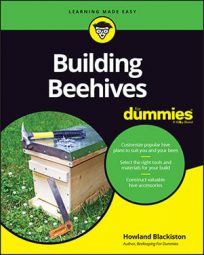When building an IPM screened bottom-board for bee hives, it's easiest to break it down into its individual components — the following tables show you how and provide instructions on how to cut those components. (Note: You'll make a couple of dado cuts for this bottom-board.)
Lumber in a store is identified by its nominal size, which is its rough dimension before it's trimmed and sanded to its finished size at the lumber mill. The actual finished dimensions are always slightly different from the nominal dimensions. For example, what a lumberyard calls 1 inch x 5 inch lumber is in fact 3/4 inch x 4-1/2 inch.
The Material column in the following table lists nominal dimensions and the Dimensions column lists the actual, final measurements.
With some adjustment to these measurements, you can scale and modify this design to work with the Warré hive, the British National hive, or even the nuc hive. The screened bottom-board's overall length and width should match the overall length and width of the standard bottom-board specified for these different hive designs.
| Quantity | Material | Dimensions | Notes |
|---|---|---|---|
| 2 | 1" x 5" knotty pine | 2" x 1-7/8" x 3/4" | These are the side rails. Dado 3/4" wide by 3/8" deep along the entire length. |
| 2 | 1" x 5" knotty pine | 16-1/4" x 2" x 3/4" | These are the long sides of the "floor." |
| 2 | 1" x 5" knotty pine | 14-3/4" x 3/4" x 3/4" | One piece is the rear cleat. The other piece is the entrance reducer. |
| 1 | 1" x 5" knotty pine | 15-1/2" x 4" x 3/4" | This is the wide front side of the "floor." |
| 1 | 1" x 5" knotty pine | 15-1/2" x 2" x 3/4" | This is the narrow rear side of the "floor." |
| 1 | Plasticor corrugated art board | 22" x 14" x 3/16" | This is the removable inspection board. |
| 1 | #8 hardware cloth | 18" x 14-1/2" | This is the screened panel that covers the opening in the floor. |
![[Credit: Illustration by Felix Freudzon, Freudzon Design]](https://www.dummies.com/wp-content/uploads/357122.image0.jpg)
![[Credit: Illustration by Felix Freudzon, Freudzon Design]](https://www.dummies.com/wp-content/uploads/357123.image1.jpg)

